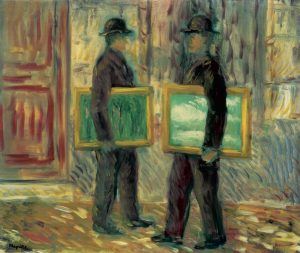Sophie Haigney in More Intelligent Life:
 It is sometimes said that Surrealist paintings are disappointing up close; perhaps we see them so often in reproduction that by the time we see the real ones in a museum they’ve lost some of their strangeness. René Magritte’s paintings could fall into that trap. His bowler hats, apples, puffy clouds and pipes have popped up on coffee mugs, tote bags and dorm-room posters for decades. Not to mention album covers: Jeff Beck used Magritte’s “The Listening Room” on the cover of his 1969 LP “Beck-Ola”. Is Magritte too ubiquitous to be uncanny? No, is the takeaway from “The Fifth Season”, an exhibition at the San Francisco Museum of Modern Art (SFMOMA). Displaying lesser-known work alongside some of his best-loved paintings, it shows that Magritte still has the power to surprise.
It is sometimes said that Surrealist paintings are disappointing up close; perhaps we see them so often in reproduction that by the time we see the real ones in a museum they’ve lost some of their strangeness. René Magritte’s paintings could fall into that trap. His bowler hats, apples, puffy clouds and pipes have popped up on coffee mugs, tote bags and dorm-room posters for decades. Not to mention album covers: Jeff Beck used Magritte’s “The Listening Room” on the cover of his 1969 LP “Beck-Ola”. Is Magritte too ubiquitous to be uncanny? No, is the takeaway from “The Fifth Season”, an exhibition at the San Francisco Museum of Modern Art (SFMOMA). Displaying lesser-known work alongside some of his best-loved paintings, it shows that Magritte still has the power to surprise.
In 1943 Magritte was living in Nazi-occupied Belgium. He was relatively well-known in artistic circles, though he was far from a household name. He had spent three years in Paris, where he was close with a group of painters which included André Breton, the leader of the Surrealist movement. He had developed his signature style: elegant canvases that challenged our ways of seeing. But the second world war had thrown him into a deep existential crisis. As he wrote to Breton: “The confusion and panic that Surrealism wanted to create in order to bring everything into question were achieved much better by the Nazi idiots than by us.” When everyday life had become horrifically surreal, why bother exploring the anxieties of the ordinary?
More here.
